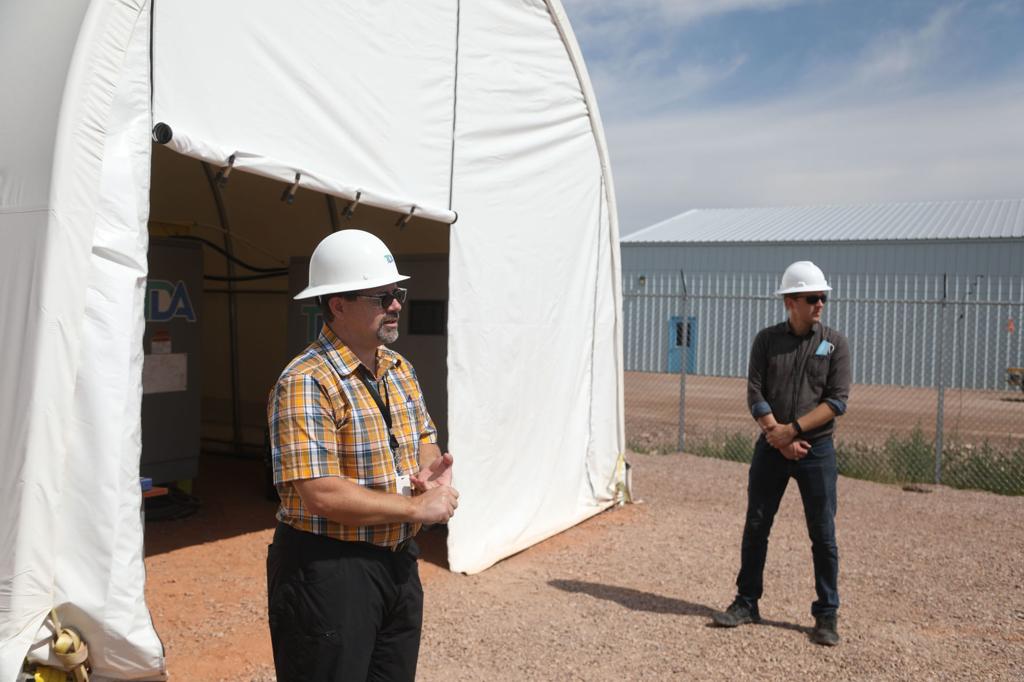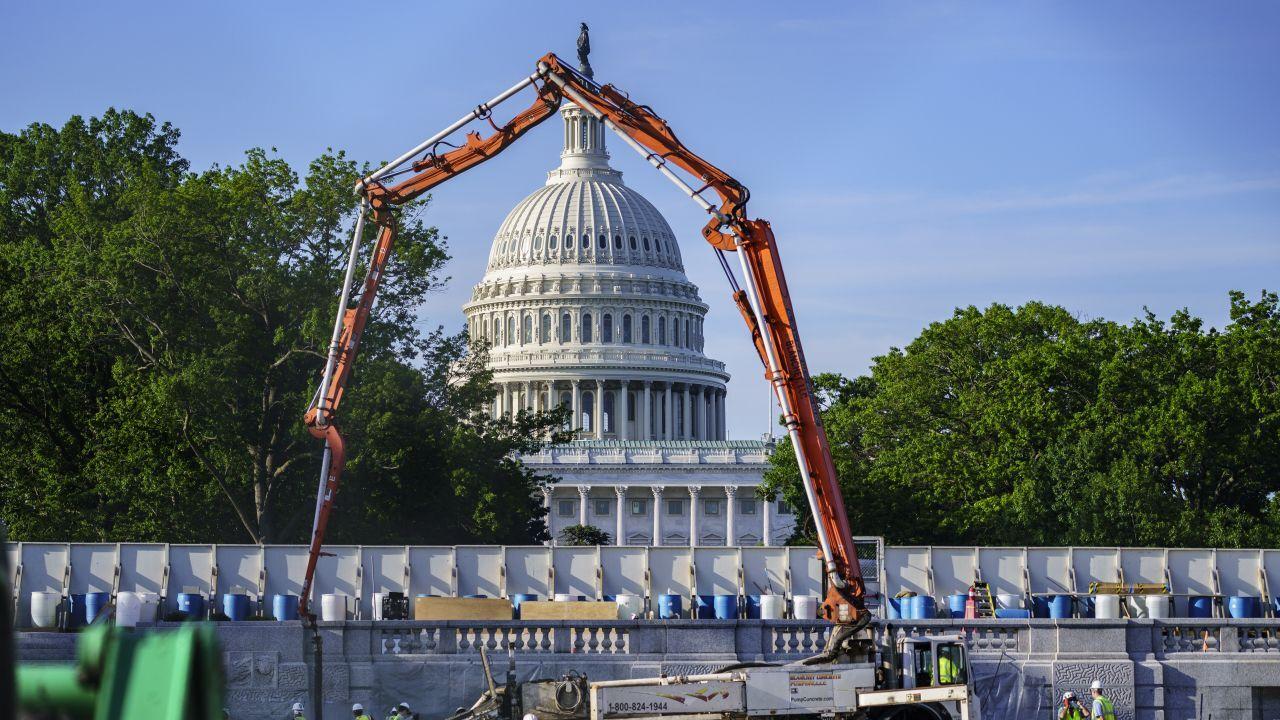Congress proposes "clean hydrogen" production hubs—with coal as a potential source
The bipartisan infrastructure bill headed for a Senate vote includes provisions for "clean hydrogen" hubs that would use fossil fuels, Bloomberg reported Monday.
The bill earmarks $8 billion to build at least four "regional clean hydrogen hubs" that would produce hydrogen for uses such as heating, manufacturing and transportation.
At least two of these hubs would be located in regions "with the greatest natural gas resources," according to the bill, and renewable energy, nuclear energy, and biomass are discussed as potential energy sources. However, so is coal.

Toyota 'Project Portal' proof-of-concept hydrogen fuel-cell powered semi tractor, for Port of LA
As Bloomberg points out, hydrogen can be stripped from water using electrolyzer devices, which seems to be the plan here, as the bill also includes $1 billion for grants to improve the efficiency of these devices. But that requires a lot of electricity, and the source of that electricity can affect the overall environmental impact of hydrogen production.
If the electricity comes from renewable sources, the hydrogen-production process does not generate greenhouse-gas emissions, Bloomberg noted. This so-called "green hydrogen" is currently more expensive than hydrogen produced using natural gas, but costs are expected to fall within a decade, to the point where green sources cost less than fossil fuels, according to Bloomberg. That in turn could make coal-powered hydrogen hubs uncompetitive.
A 2020 IHS Markit study predicted that green hydrogen produced using renewable energy could be cost-competitive with hydrogen made from natural gas by 2030. The California Energy Commission came to a similar conclusion, saying in its own 2020 report that hydrogen fuel-cell cars could reach price parity with gasoline by 2025.

2021 Hyundai Nexo
That's a more encouraging picture than just a few years ago. A 2014 University of California-Davis study predicted that cheap natural gas would be needed to make hydrogen cost competitive with gasoline.
Hyundai has been one of the biggest cheerleaders for a big-picture hydrogen policy, and has cited a McKinsey analysis suggesting hydrogen (assumed to be green in this analysis) could make up 18% of global "final energy demand" by 2050.
However, infrastructure remains a big barrier— and that's led to some very creative proposals on how to transport hydrogen from clean energy sources to end points—including using the existing fossil-fuel infrastructure.
AUGUST 3, 2021
The bipartisan infrastructure bill headed for a Senate vote includes provisions for "clean hydrogen" hubs that would use fossil fuels, Bloomberg reported Monday.
The bill earmarks $8 billion to build at least four "regional clean hydrogen hubs" that would produce hydrogen for uses such as heating, manufacturing and transportation.
At least two of these hubs would be located in regions "with the greatest natural gas resources," according to the bill, and renewable energy, nuclear energy, and biomass are discussed as potential energy sources. However, so is coal.

Toyota 'Project Portal' proof-of-concept hydrogen fuel-cell powered semi tractor, for Port of LA
As Bloomberg points out, hydrogen can be stripped from water using electrolyzer devices, which seems to be the plan here, as the bill also includes $1 billion for grants to improve the efficiency of these devices. But that requires a lot of electricity, and the source of that electricity can affect the overall environmental impact of hydrogen production.
If the electricity comes from renewable sources, the hydrogen-production process does not generate greenhouse-gas emissions, Bloomberg noted. This so-called "green hydrogen" is currently more expensive than hydrogen produced using natural gas, but costs are expected to fall within a decade, to the point where green sources cost less than fossil fuels, according to Bloomberg. That in turn could make coal-powered hydrogen hubs uncompetitive.
A 2020 IHS Markit study predicted that green hydrogen produced using renewable energy could be cost-competitive with hydrogen made from natural gas by 2030. The California Energy Commission came to a similar conclusion, saying in its own 2020 report that hydrogen fuel-cell cars could reach price parity with gasoline by 2025.

2021 Hyundai Nexo
That's a more encouraging picture than just a few years ago. A 2014 University of California-Davis study predicted that cheap natural gas would be needed to make hydrogen cost competitive with gasoline.
Hyundai has been one of the biggest cheerleaders for a big-picture hydrogen policy, and has cited a McKinsey analysis suggesting hydrogen (assumed to be green in this analysis) could make up 18% of global "final energy demand" by 2050.
However, infrastructure remains a big barrier— and that's led to some very creative proposals on how to transport hydrogen from clean energy sources to end points—including using the existing fossil-fuel infrastructure.
INFRASTRUCTURE
Billions for carbon capture, hydrogen, advanced nuclear included in bipartisan infrastructure plan


According to a summary of the 2,700-page bill, the package would allocate more than $8 billion toward carbon capture efforts through 2026, including $100 million for the Department of Energy’s Carbon Capture Technology Program, $300 million for the development of carbon oxide products, $2 billion for carbon dioxide transport infrastructure, $2.5 billion for the commercialization of carbon sequestration projects and $3.5 billion for four regional direct air capture hubs.
The influx of federal spending could boost Wyoming’s existing carbon capture, utilization and storage efforts, including the University of Wyoming’s CarbonSAFE sequestration project and other initiatives at UW and throughout the state.
For hydrogen, the bill would reestablish and expand the DOE Hydrogen Program to include additional clean hydrogen programs as well as a national strategy for advancing clean hydrogen.
It authorizes $500 million to support a domestic clean hydrogen supply chain, $1 billion for a hydrogen commercialization program and $8 billion for four clean hydrogen hubs that “demonstrate the production, processing, delivery, storage, and end-use of clean hydrogen” and “can be developed into a national clean hydrogen network to facilitate a clean hydrogen economy.”
Under the bill, both blue and green hydrogen qualify as clean, though there is some disagreement about whether blue hydrogen — a classification for hydrogen generated using natural gas that requires that the carbon released as a byproduct be sequestered — can be considered as clean as green hydrogen, which is produced using renewable energy.
Many in Wyoming, including the oil and gas industry, see blue hydrogen as a way to keep the state’s gas production competitive as power plants’ demand for natural gas wanes. Several energy companies received grants last month from the Wyoming Energy Authority to support feasibility studies on the production and use of both blue and green hydrogen.
The bill also directs the DOE to conduct a report on the feasibility of using advanced nuclear technologies to meet U.S. climate goals, and introduces a $6 billion civil nuclear credit program to help keep existing nuclear reactors operating.
That expanded federal support for nuclear power would come as nuclear design company TerraPower begins the permitting process for the advanced reactor it plans to build at one of four retiring Wyoming coal plants.
Majority Leader Chuck Schumer has said he hopes to finalize amendments to the bill and pass it through the Senate before the monthlong August recess starts next week.
Billions for carbon capture, hydrogen, advanced nuclear included in bipartisan infrastructure plan

Dave Gribble of TDA Research gives a tour of the first carbon capture research project on the ground at the Integrated Test Center outside Gillette in August 2020. The infrastructure package now in the Senate includes money for emerging energy technologies. Cayla Nimmo, Star-Tribune▲
Nicole Pollack
Aug 3, 2021
The $1 trillion bipartisan infrastructure package completed over the weekend includes billions in funding for three emerging energy technologies that Wyoming is already exploring: clean hydrogen, carbon capture and advanced nuclear power.
After a precarious, monthslong negotiation process that saw the bipartisan deal nearly fall through, the Senate voted Wednesday to open debate on the infrastructure plan by a margin of 67-32. Wyoming Sens. John Barrasso and Cynthia Lummis both voted against advancing the bill.
In a statement, Barrasso characterized the legislation as governmental overreach — calling it “the Biden administration’s takeover of America’s electric system” — and expressed concern about where the funding would come from.
“We should be investing in our infrastructure responsibly. Instead, this bill spends too much and mandates policies that are bad for Wyoming,” he said.
Despite the senators’ misgivings about the infrastructure plan, some of the programs covered under its hefty price tag would support the development of advanced energy sources, which many in Wyoming say are key to revitalizing the state’s economy as natural resource revenue continues to decline.
Nicole Pollack
Aug 3, 2021
The $1 trillion bipartisan infrastructure package completed over the weekend includes billions in funding for three emerging energy technologies that Wyoming is already exploring: clean hydrogen, carbon capture and advanced nuclear power.
After a precarious, monthslong negotiation process that saw the bipartisan deal nearly fall through, the Senate voted Wednesday to open debate on the infrastructure plan by a margin of 67-32. Wyoming Sens. John Barrasso and Cynthia Lummis both voted against advancing the bill.
In a statement, Barrasso characterized the legislation as governmental overreach — calling it “the Biden administration’s takeover of America’s electric system” — and expressed concern about where the funding would come from.
“We should be investing in our infrastructure responsibly. Instead, this bill spends too much and mandates policies that are bad for Wyoming,” he said.
Despite the senators’ misgivings about the infrastructure plan, some of the programs covered under its hefty price tag would support the development of advanced energy sources, which many in Wyoming say are key to revitalizing the state’s economy as natural resource revenue continues to decline.

According to a summary of the 2,700-page bill, the package would allocate more than $8 billion toward carbon capture efforts through 2026, including $100 million for the Department of Energy’s Carbon Capture Technology Program, $300 million for the development of carbon oxide products, $2 billion for carbon dioxide transport infrastructure, $2.5 billion for the commercialization of carbon sequestration projects and $3.5 billion for four regional direct air capture hubs.
The influx of federal spending could boost Wyoming’s existing carbon capture, utilization and storage efforts, including the University of Wyoming’s CarbonSAFE sequestration project and other initiatives at UW and throughout the state.
For hydrogen, the bill would reestablish and expand the DOE Hydrogen Program to include additional clean hydrogen programs as well as a national strategy for advancing clean hydrogen.
It authorizes $500 million to support a domestic clean hydrogen supply chain, $1 billion for a hydrogen commercialization program and $8 billion for four clean hydrogen hubs that “demonstrate the production, processing, delivery, storage, and end-use of clean hydrogen” and “can be developed into a national clean hydrogen network to facilitate a clean hydrogen economy.”
Under the bill, both blue and green hydrogen qualify as clean, though there is some disagreement about whether blue hydrogen — a classification for hydrogen generated using natural gas that requires that the carbon released as a byproduct be sequestered — can be considered as clean as green hydrogen, which is produced using renewable energy.
Many in Wyoming, including the oil and gas industry, see blue hydrogen as a way to keep the state’s gas production competitive as power plants’ demand for natural gas wanes. Several energy companies received grants last month from the Wyoming Energy Authority to support feasibility studies on the production and use of both blue and green hydrogen.
The bill also directs the DOE to conduct a report on the feasibility of using advanced nuclear technologies to meet U.S. climate goals, and introduces a $6 billion civil nuclear credit program to help keep existing nuclear reactors operating.
That expanded federal support for nuclear power would come as nuclear design company TerraPower begins the permitting process for the advanced reactor it plans to build at one of four retiring Wyoming coal plants.
Majority Leader Chuck Schumer has said he hopes to finalize amendments to the bill and pass it through the Senate before the monthlong August recess starts next week.
No comments:
Post a Comment